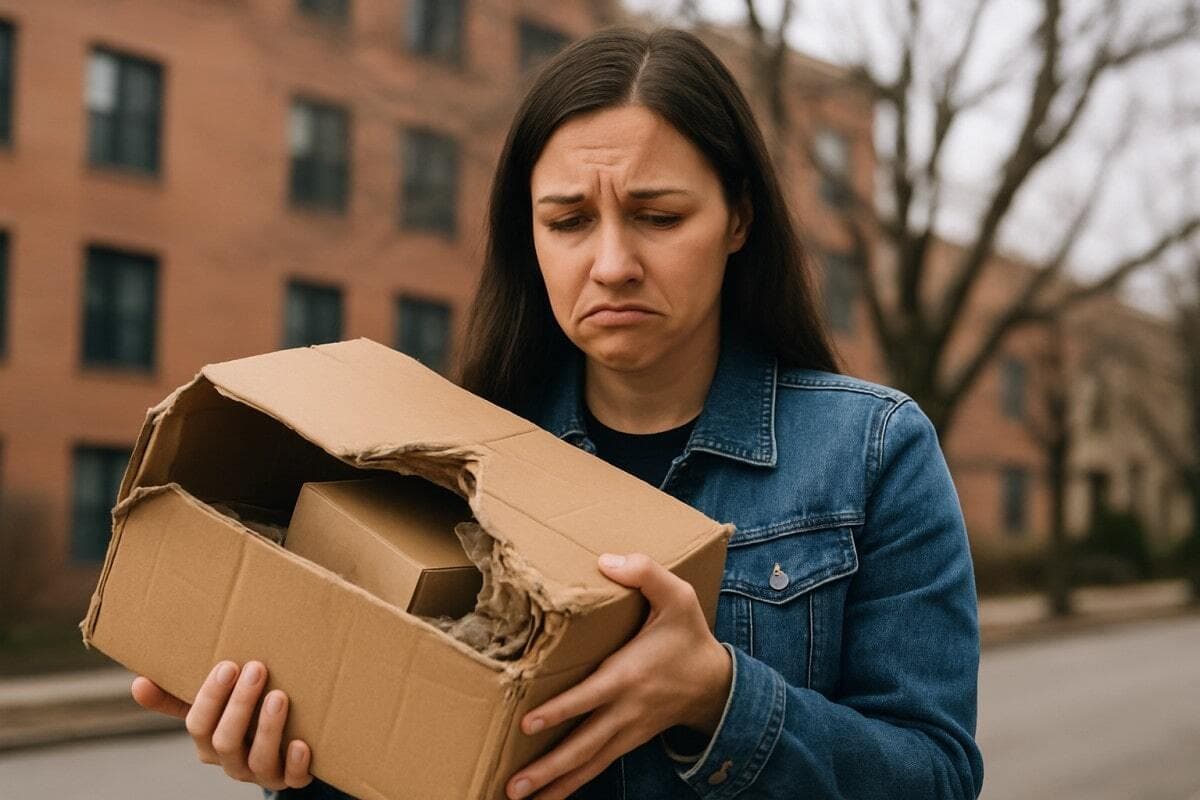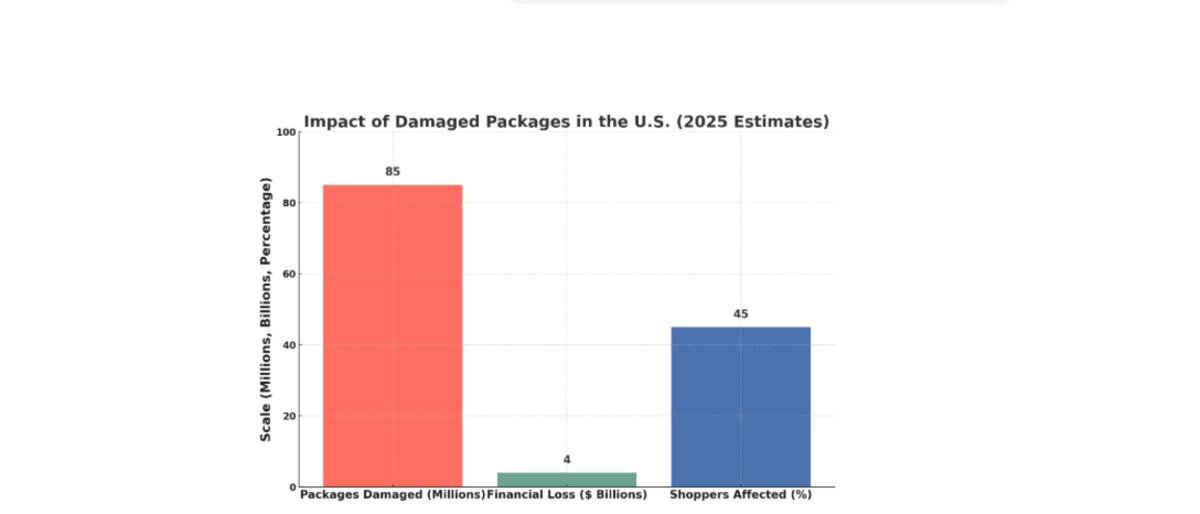
The e-commerce boom has transformed how Americans shop, but it has also created a growing crisis: damaged packages. With a staggering 85 million packages reported damaged in 2025 alone, consumers are increasingly frustrated by broken, mishandled, or defective deliveries. The scale of the problem is not just an inconvenience, it represents billions in losses, declining customer trust, and environmental waste.
Recent logistics studies estimate that around 3-4% of all shipped packages in the U.S. arrive damaged. With nearly 21.5 billion packages delivered in 2024, this translates to more than 85 million parcels arriving broken, dented, or otherwise compromised.
Key Stats:

These numbers are up significantly from just five years ago, highlighting how the rush for faster, cheaper delivery is compromising package safety.
1. The Rise of Ultra-Fast & Hyperlocal Deliveries (Q-Commerce)
The demand for 30-minute, same-day, and next-day deliveries has exploded. Companies now prioritize speed over care, using crowd-shipping models and micro-fulfillment centers.
While these models, like DoorDash and Gopuff, excel in speed, they often rely on independent contractors with minimal packaging and handling training. Packages are frequently jostled in backpacks, bike carriers, or tightly packed delivery vans, increasing the risk of damage.
2. Overloaded Logistics Systems
As the number of deliveries per day surges, warehouse and delivery staff face tighter deadlines and mounting pressure. Mishandling often occurs during sorting, loading, and final delivery stages.
3. Poor Packaging Standards
Sellers rushing to fulfill orders may cut corners on packaging materials. Insufficient cushioning, improperly sealed boxes, or inappropriate packaging sizes are common, particularly among smaller or third-party sellers.
4. Subscription-Based Delivery Surge
The rise of subscription models like Amazon Prime and Walmart+ has fueled consumer expectations for free, fast, and frequent deliveries.
While customers benefit from convenience, the sheer volume of subscription deliveries overwhelms carriers, increasing the likelihood of rushed handling.
5. Lack of Personalized Delivery Options
Consumers increasingly demand flexibility like delivery-time selection, in-flight address changes, and locker pickups.
When these options aren't available, packages may sit unattended on doorsteps, get thrown over fences, or be left in unsafe locations where they are more prone to damage.
1. Financial Losses
2. Environmental Impact
3. Customer Trust and Brand Loyalty
1. Improved Packaging Standards
Many retailers are now investing in more durable, eco-friendly, and damage-resistant packaging.
2. Enhanced Training for Delivery Staff
Carriers like UPS and FedEx have implemented better training programs focusing on careful handling, particularly for fragile items. Some ultra-fast delivery apps are also beginning to provide onboarding material that emphasizes package care over speed.
3. Technology-Driven Solutions
Companies are using AI and machine learning to optimize package stacking, loading, and route planning to reduce the risk of mishandling during transit.
4. Expansion of Secure Locker Networks
Retailers like Amazon, Walmart, and other logistics partners are expanding locker and pickup point networks, giving customers safer, controlled delivery options that minimize damage risks associated with doorstep drops.
5. Flexible Delivery Scheduling
More carriers are offering customized delivery windows, address changes, and rerouting options to ensure packages are not left in high-risk locations.
6. Collaboration with Third-Party Package Receiving Services
Some retailers are beginning to partner with third-party package receiving services like Stowfly to give customers the option of using secure, local pickup points instead of home delivery.
Stowfly, a secure package receiving and storage service, offers a smart, secure, and customer-centric alternative to the traditional home delivery model, directly addressing many of the causes behind package damage. By partnering with trusted neighborhood shops and cafes to act as your secondary delivery address, your packages are safely received and stored until you pick them up at your convenience.
Avoid the stress of damaged or stolen packages—Stowfly gives you secure, easy pickups you can trust. Try it free for one month!
1. Safe, Secure Package Receiving Locations
Stowfly has a network of vetted locations (local stores, businesses, and storage partners) where packages are securely received and stored until convenient pickup by the customer.
2. Minimized Handling and Consolidated Deliveries
When customers use Stowfly, packages are delivered directly to a safe location with minimal additional handling.
3. Supports Flexible, Personalized Delivery
Stowfly allows customers to choose where and when to pick up their packages.
4. Provides a Solution for Subscription-Based and High-Frequency Deliveries
For Amazon Prime, Walmart+, and other frequent shoppers, Stowfly acts as a reliable receiving hub that prevents damaged deliveries by taking the final delivery off the overburdened courier's plate.
Angela from Chicago: "I used to get fragile items delivered to my apartment, but so many times they arrived broken. Since switching to Stowfly, I’ve had zero issues. Everything is stored securely until I pick it up."
Mike from New York: "My building has package theft issues, and I've even had packages thrown over the fence. With Stowfly, I pick up my deliveries from a nearby cafe and it’s been a game changer. No more damaged goods."
Find more convenient locations near you. Search nearby Stowfly package receiving spots.
The U.S. package delivery system is strained under the weight of consumer expectations for speed, convenience, and low costs. Unfortunately, this has led to an alarming rise in damaged and mishandled parcels, with over 85 million packages affected in 2025 alone.
From ultra-fast delivery pressures to insufficient packaging and overloaded logistics chains, the causes of damaged deliveries are multifaceted and growing. Subscription-based services and a lack of personalized delivery options further compound the problem.
Stowfly offers a smarter, safer, and more sustainable alternative. By providing secure package receiving locations, reducing courier rush, and enabling flexible pickups, Stowfly helps consumers avoid the disappointment and financial loss of damaged packages.
Secure your Stowfly spot starting at only $7.50/month for up to 5 packages, or $15/month to conveniently receive up to 15 packages. From Amazon to USPS, FedEx, UPS, and every online store in between, easily and securely receive all your deliveries at a package receiving location.
As the e-commerce landscape continues to evolve, services like Stowfly are essential to creating a more reliable and customer-friendly delivery ecosystem.
Find out more in this blog about 2025 Online shopping trends and the future of package deliveries.